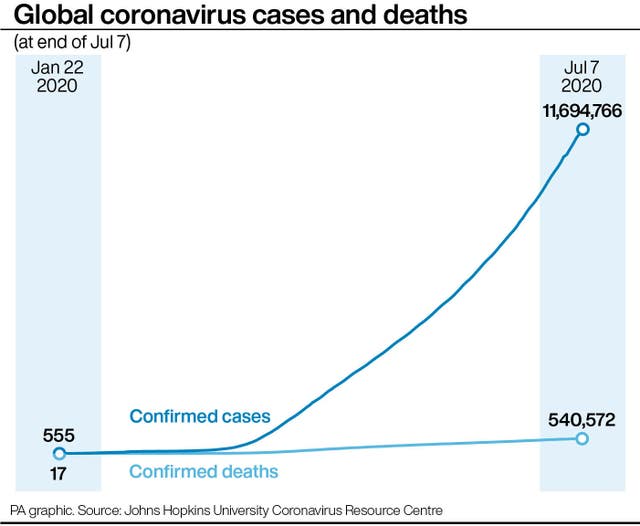
The World Health Organisation (WHO) has acknowledged there is “emerging evidence” that Covid-19 could be spread through particles in the air.
Professor Benedetta Allegranzi, technical lead for infection prevention and control, said the possibility of airborne transmission in “crowded, closed, poorly ventilated” settings could not be ruled out.
READ MORE: WHO praises Scotland's 'promising' minimum alcohol pricing
It comes after more than 200 scientists wrote an open letter to the agency urging officials to recognise the possibility of airborne transmission of the virus.
Media briefing on #COVID19 with @DrTedros https://t.co/VpsVJPDu6s
— World Health Organization (WHO) (@WHO) July 7, 2020
Current guidelines from the WHO focus on the virus being spread primarily through droplets from the nose or mouth, which are expelled when an infected person coughs, sneezes or speaks.
The Geneva-based agency advises precautions to avoid these droplets, such as social distancing and regular hand washing.
Published in the Clinical Infectious Diseases journal, the letter’s signatories call on health officials to update guidance to include measures which would mitigate the risk of airborne transmission.
The group of 239 experts outline studies which they say suggests coronavirus can spread through smaller particles that linger in the air.
While hand washing and social distancing are appropriate, the signatories say these measures are “insufficient” in providing protection from “virus-carrying respiratory microdroplets” released into the air by those with Covid-19.
 (PA Graphics)
(PA Graphics)
According to the group, measures that should be taken include providing sufficient ventilation, to minimise recirculating air, and avoiding overcrowding, particularly on public transport.
When asked about the letter during a press briefing on Tuesday, Prof Allegranzi said officials had been in discussions with the letter’s signatories.
“We acknowledge that there is emerging evidence in this field, as in all other fields, regarding the Covid-19 virus and pandemic,” she told reporters.
READ MORE: The revolutionary new vision for a post-Covid Scottish economy
“And therefore, we believe that we have to be open to this evidence and understand its implications regarding the modes of transmission, and also regarding the precautions that need to be taken.”
She added that while airborne transmission could not be ruled out in certain conditions, the evidence was not “definitive” and needed to continue to be gathered.
There are several ways to reduce your risk of COVID-19.
Stay healthy and let's all prevent the spread of #COVID19!#StaySafe pic.twitter.com/SOmafuSaR8
— World Health Organization Philippines (@WHOPhilippines) July 8, 2020
Dr David Nabarro, a special envoy to the WHO on Covid-19, said that while airborne transmission was “certainly part of the puzzle”, it is not the main route of transmission.
“The major way in which that this virus is transmitted is through droplets which come out when you cough, sneeze or even shout,” he told the BBC Radio 4 Today programme
“But there does seem to be the possibility that very small particles containing virus can move further.
“It is certainly part of the puzzle. The key question is just how important is it.
“Right now we think it is not the major means of transmission. The major means of transmission is droplets, which is why we talk about one to two metres distance as being the key thing to avoid spread.”


Why are you making commenting on The Herald only available to subscribers?
It should have been a safe space for informed debate, somewhere for readers to discuss issues around the biggest stories of the day, but all too often the below the line comments on most websites have become bogged down by off-topic discussions and abuse.
heraldscotland.com is tackling this problem by allowing only subscribers to comment.
We are doing this to improve the experience for our loyal readers and we believe it will reduce the ability of trolls and troublemakers, who occasionally find their way onto our site, to abuse our journalists and readers. We also hope it will help the comments section fulfil its promise as a part of Scotland's conversation with itself.
We are lucky at The Herald. We are read by an informed, educated readership who can add their knowledge and insights to our stories.
That is invaluable.
We are making the subscriber-only change to support our valued readers, who tell us they don't want the site cluttered up with irrelevant comments, untruths and abuse.
In the past, the journalist’s job was to collect and distribute information to the audience. Technology means that readers can shape a discussion. We look forward to hearing from you on heraldscotland.com
Comments & Moderation
Readers’ comments: You are personally liable for the content of any comments you upload to this website, so please act responsibly. We do not pre-moderate or monitor readers’ comments appearing on our websites, but we do post-moderate in response to complaints we receive or otherwise when a potential problem comes to our attention. You can make a complaint by using the ‘report this post’ link . We may then apply our discretion under the user terms to amend or delete comments.
Post moderation is undertaken full-time 9am-6pm on weekdays, and on a part-time basis outwith those hours.
Read the rules here